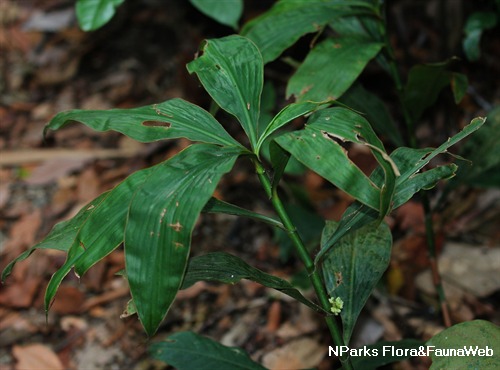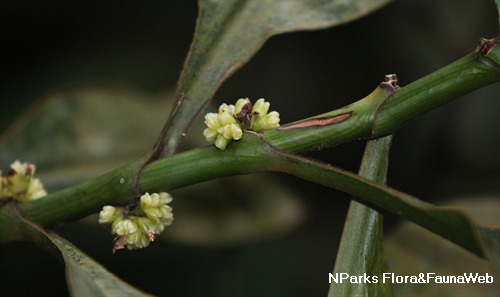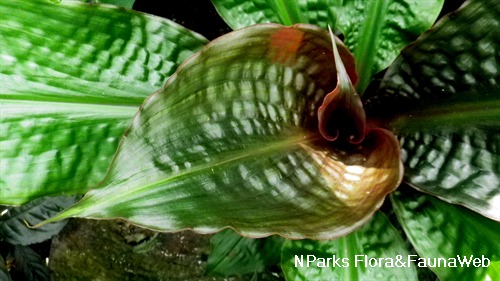
Back
Amischotolype gracilis (Ridl.) I.M.Turner
| Family Name: | Commelinaceae |
| Synonyms: | Forrestia gracilis Ridl. |
| Common Name: | Tebu Kera, Pokok Sampu Landak, Setawar Betina, Tebu Primat, Buah Anku |
Amischotolype gracilis is a herbaceous rhizomatous herb native to Singapore. It produces erect green stems and green leaves with dense orange to red-brown submarginal hairs and a purple underside. The flowers are borne in dense globular inflorescence on the axil of the stems.
Name
Classifications and Characteristics
| Plant Division | Angiosperms (Flowering Seed Plants) (Monocotyledon) |
|---|---|
| Plant Growth Form | Herbaceous Plant |
| Lifespan (in Singapore) | Perennial |
| Mode of Nutrition | Autotrophic |
Biogeography
| Native Distribution | Peninsular Malaysia, Singapore, Sumatra, Borneo |
|---|---|
| Native Habitat | Terrestrial (Primary Rainforest, Secondary Rainforest, Freshwater Swamp Forest) |
| Preferred Climate Zone | Tropical |
| Local Conservation Status | Native to Singapore (Least Concern (LC)) |
Description and Ethnobotany
| Growth Form | It is a perennial, rhizomatous herb with erect aboveground stems up to 0.9 - 2.5 m tall. |
|---|---|
| Roots | Stitl roots can be short or long, growing from the base of the erect stems. |
| Foliage | The leaves are smooth (rarely covered in short hairs) and narrowly elliptic in shape, up to 20 - 45 cm long and 4 - 8.7 cm wide. The upper surface is green and predominantly smooth with dense, orange to red-brown submarginal hairs, and the lower is green or dark purple. The leaves are sheathed with a pseudopetiole up to 5.5 cm long and 1 - 3mm wide. |
| Stems | The aboveground stem is erect, green and smooth, up to 0.9 - 2.5 m long, and grows from short creeping rhizomes. |
| Flowers | The inflorescence is a condensed, near-globose thyrse, subtended by small, pale green to purplise bracts and borne on the axils of the stems. The flowers are small and bisexual, with three white to green sepals, three white petals, six stamens and a single ovary. |
| Fruit | The fruit is an obovoid capsule (a type of dry, dehiscent fruit), either white to purplish red or purple. The sepals change from green to purplish when in fruit. Each fruit produce 2 seeds per locule, accompanied by orange aril. |
| Habitat | It can be found in primary or secondary rainforests, montane forests (rarely in kerangas or peat swamp forests), swampy forests, dry streambeds, or partly shaded slopes, from 0 to 1350 m above sea level. It can grow in relatively dry to wet and swampy conditions on granite, clay and alluvial soil. |
| Associated Fauna | In Malaysia, this species is known to be eaten by elephants. <3> |
| Cultivation | This species does well in shade or partial shade and grows in various soil types. It can be propagated by seeds and stem cuttings. |
| Etymology | The genus Amischotolype is derived from Ancient Greek amischos"without stalk" and tolupe "cluster", referring to the sessile cluster of flowers. The specific epithet gracilis means "slender, graceful". |
| Ethnobotanical Uses | Medicinal: The decoction made by boiling the plant is drank to relief pains in the body. <1> |
Landscaping Features
| Landscape Uses | Parks & Gardens, Small Gardens, Reforestation |
|---|---|
| Thematic Landscaping | Bird & Wildlife Garden |
Plant Care and Propagation
| Light Preference | Semi-Shade, Full Shade |
|---|---|
| Water Preference | Lots of Water, Moderate Water, Occasional Misting |
| Rootzone Tolerance | Moist Soils, Fertile Loamy Soils |
| Pest(s) | Chewing Insects, Sucking Insects |
| Propagation Method | Seed, Stem Cutting |
Foliar
| Foliage Retention | Evergreen |
|---|---|
| Mature Foliage Colour(s) | Green, Green - Light Green, Purple |
| Mature Foliage Texture(s) | Raised / Sunken Veins, Smooth |
| Foliar Modification | Trichome / Hair |
| Foliar Type | Simple / Unifoliate |
| Foliar Arrangement Along Stem | Spiral |
| Foliar Shape(s) | Non-Palm Foliage (Elliptical) |
| Foliar Venation | Parallel |
| Foliar Margin | Ciliate / Hairy |
| Foliar Apex - Tip | Acuminate |
| Foliar Base | Clasping |
| Typical Foliar Area | Mesophyll ( 45cm2 - 182.25 cm2 ) |
| Leaf Area Index (LAI) for Green Plot Ratio | 3.5 (Shrub & Groundcover - Monocot) |
Non - Foliar and Storage
| Stem Type & Modification | Herbaceous |
|---|---|
| Root Type | Underground (Fibrous Root), Aboveground (Prop / Stilt Root) |
Floral (Angiosperm)
| Flower & Plant Sexuality | Bisexual Flowers |
| Flower Colour(s) | White, Green |
|---|---|
| Flower Texture(s) | Thin |
| Flower Grouping | Cluster / Inflorescence |
| Flower Location | Axillary |
| Flower Symmetry | Radial |
| Inflorescence Type | Thyrse |
| Ovary Position | Superior / Hypogynous |
| Flowering Habit | Polycarpic |
Fruit, Seed and Spore
| Mature Fruit Colour(s) | White, Purple, Red |
|---|---|
| Mature Fruit Texture(s) | Hairy / Hirsute |
| Fruit Classification | Simple Fruit |
| Fruit Type | |
| Seed Description | 2 seeds per locule, accompanied by orange aril. |
| Seed Quantity Per Fruit | Few (1-5) |
References
| References | <1> Burkill, I.H, Mohamed Haniff. (1930). Malay Village Medicine. The Gardens' Bulletin, Straits Settlements Singapore 6(6-10). https://www.nparks.gov.sg/sbg/research/publications/gardens'-bulletin-singapore/-/media/sbg/gardens-bulletin/4-4-06-2-01-y1930-v6p2-gbs-pg-165.pdf (accessed 7 April 2025) <2> Duistermaat, H. (2012). A taxonomic revision of Amischotolype (Commelinaceae) in Asia Helena Duistermaat. Gardens’ Bulletin Singapore 64(1): pp 51–131. <3> Nur Nadiah Md Yusof, et. al. (2022). Guidelines for the Cultivation of Food Plants for Wildlife, pp.34. Malaysia: Department of Wildlife and National Parks (DWNP) Peninsular Malaysia. |
|---|
Image Repository
Others
| Master ID | 31574 |
|---|---|
| Species ID | 5973 |
| Flora Disclaimer | The information in this website has been compiled from reliable sources, such as reference works on medicinal plants. It is not a substitute for medical advice or treatment and NParks does not purport to provide any medical advice. Readers should always consult his/her physician before using or consuming a plant for medicinal purposes. |



